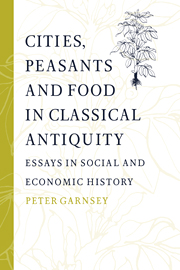Book contents
- Frontmatter
- Contents
- Preface
- Editor's preface
- Acknowledgements
- List of abbreviations
- PART I CITIES
- 1 Aspects of the decline of the urban aristocracy in the empire
- 2 Independent freedmen and the economy of Roman Italy under the Principate
- 3 Economy and society of Mediolanum under the Principate
- 4 Urban property investment in Roman society
- 5 An association of builders in late antique Sardis
- PART II PEASANTS
- PART III FOOD
- Bibliography
- Index
4 - Urban property investment in Roman society
Published online by Cambridge University Press: 02 December 2009
- Frontmatter
- Contents
- Preface
- Editor's preface
- Acknowledgements
- List of abbreviations
- PART I CITIES
- 1 Aspects of the decline of the urban aristocracy in the empire
- 2 Independent freedmen and the economy of Roman Italy under the Principate
- 3 Economy and society of Mediolanum under the Principate
- 4 Urban property investment in Roman society
- 5 An association of builders in late antique Sardis
- PART II PEASANTS
- PART III FOOD
- Bibliography
- Index
Summary
When historians of the Roman economy write of investments in land, they normally have in mind rural property. The role of investment in urban property in the economy is seldom discussed. Moreover, what littlè has been said on the subject suggests that its significance is inadequately understood.
The standard works on economic history might be expected to place urban property firmly in its economic context. Tenney Frank recognizes the following sources of income for wealthy Romans in the late Republic: commerce and trade, provincial investment and money-lending (Pompey, Brutus, Atticus), managing and enlarging an inheritance (Atticus, his landowning and industrial concerns, inter alia), dealing in real estate, the legal profession, acting, and provincial government. Urban rents are not on the list. Rostovtzeff writes of the local aristocracy of Italian cities in the first century BC in the following terms: ‘Most of them were landowners, some were owners of houses let at rent, of various shops; some carried on money-lending and banking operations.’ Here acknowledgement is made of the relevance of urban property to the matter of the sources of wealth of the propertied class. But the reference is an isolated one. When, for example, Rostovtzeff enumerates those investments supposedly favoured by the new rich, the items mentioned are rural property, money-lending and Italian industry. Either it is by a mere oversight that urban property is omitted here, or we must conclude that in Rostovtzeff's view urban property was not taken at all seriously as an economic investment.
- Type
- Chapter
- Information
- Cities, Peasants and Food in Classical AntiquityEssays in Social and Economic History, pp. 63 - 76Publisher: Cambridge University PressPrint publication year: 1998
- 2
- Cited by



